Control and Coordination Class 10 Notes – Easy Diagrams, NCERT Concepts & CBSE 2025-26 Guide
Class 10 Science Chapter 6 Control and Coordination Notes
"Control and Coordination is a key chapter in Class 10 Science (Biology), focusing on how the nervous and endocrine systems work together to manage body functions. If you find this topic challenging, these easy-to-follow notes will help you grasp the concepts more effectively."
| Subject | Science (Biology) |
| Class | 10 |
| Board | CBSE & State Boards |
| Chapter No. | 6 |
| Chapter Name | Control and Coordination |
| Type | Notes |
| Session | 2025-26 |
Table of Contents
Introduction
- Life processes (R, E, N, T) are involved in the maintenance functions of living organisms.
- A cat running, children playing on swings, buffaloes chewing cud – these are not movements caused by growth. These movements are a response to a change in the environment of the organism.
- All these movements, in response to the environment, are carefully controlled.
- Living organisms must use systems to provide control and coordination.
- Specialized tissues are used to provide these control and coordination activities.
Animals - Nervous System
In animals, control and coordination are provided by nervous and muscular tissues.
All information from our environment is detected by the specialized tips of some nerve cells.
The receptors are usually located in our sense organs, such as the inner ear, the nose, the tongue, and so on.
| Olfactory receptors (detects smell) | Nose |
| Thermo receptors (temperature receptors) | Skin |
| Gustatoreceptors (detects taste) | Tongue |
| Photoreceptors (detects light) | Eye |
Structure of a Neuron

- Information is first received at dendrite.
- It travels through the axon.
- It is released at the nerve ending/axon terminal.
The electrical impulse travels in a neuron from Dendrite → cell body → axon → axonal end.
A gap between a pair of adjacent nerve cell over which nerve impulses passes is called the synapse.
What happens in Reflex Actions?
Reflex actions are those that are performed without thinking about it, or without feeling in control of our reactions.
The path through which signals are transmitted from a receptor to a muscle or a gland is called the reflex arc.
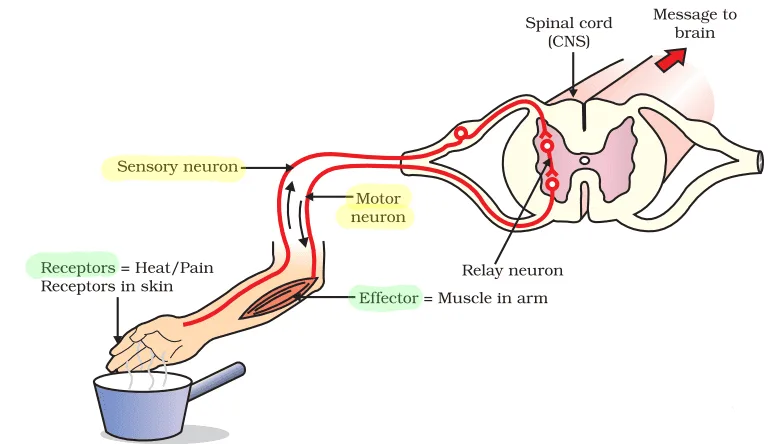
Sense Organ -----(Sensory neuron)→ Spinal Cord (CNS) ----(Motor neuron)→ Effector (Muscle in arm).
Human Brain
The spinal cord is made up of nerves that supply information to think about.
The brain and spinal cord constitute the central nervous system. They receive information from all parts of the body and integrate it.
The communication between the central nervous system and the other parts of the body is facilitated by the peripheral nervous system consisting of cranial nerves arising from the brain and spinal nerves arising from the spinal cord.
The brain has three major parts or regions, namely the fore-brain, mid-brain, and hind-brain.
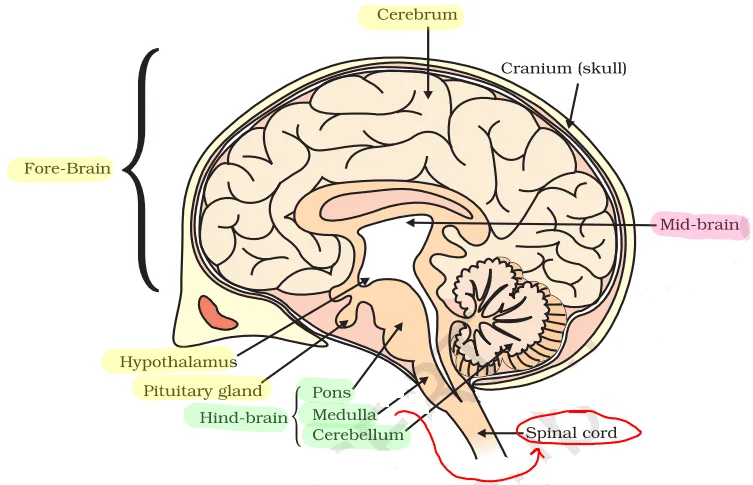
Forebrain
- Cerebrum: The cerebrum is the largest part of the brain and is responsible for higher-order functions such as thinking, planning, learning, memory, emotions, and language.
- Thalamus: The thalamus is a relay station for sensory information from the body to the cerebrum. It also helps to regulate sleep, wakefulness, and emotions.
- Hypothalamus: The hypothalamus is a small but important structure that regulates a variety of body functions, including hunger, thirst, body temperature, and sexual behavior.
Midbrain
- The midbrain is involved in visual and auditory reflexes, in maintaining consciousness, arousal, and attention.
Hindbrain
- Pons: The pons is a structure that connects the midbrain to the medulla. It is involved in motor control, respiration, and sleep.
- Medulla oblongata: The medulla oblongata is the lowest part of the brainstem. It is involved in a variety of vital functions, including breathing, heart rate, blood pressure, and digestion.
- Cerebellum: The cerebellum is a small structure that is located behind the brainstem. It is involved in coordination, maintaining posture and balance of the body, and motor learning.
How are these Tissues protected?
The brain is covered with a cranium and the spinal cord is protected by the vertical column or backbone. These bony covers protect both from external injuries. Both the brain and spinal cord are covered with three membranes called meninges. The space between meninges is filled with a fluid called cerebrospinal fluid which protects them from mechanical shock.
How does the Nervous Tissue cause Action?
When a nerve impulse reaches the muscle, the muscle fibre must move. Muscle cells move by changing their shape so that they shorten.
Muscle cells have special proteins that change both their shape and their arrangement in the cell in response to nervous electrical impulses. When this happens, new arrangements of these proteins give the muscle cells a shorter form.
Coordination in Plants
Plants show two different types of movement –
- one dependent on growth
- the other independent of growth.
1. Immediate Response to Stimulus (Movement independent of growth):
Plants also use electrical-chemical means to convey this information from cell to cell, but unlike in animals, there is no specialized tissue in plants for the conduction of information.
Instead of the specialized proteins found in animal muscle cells, plant cells change shape by changing the amount of water in them, resulting in swelling or shrinking, and therefore in changing shapes.
2. Movement Due to Growth:
Some plants like the pea plant climb up other plants or fences by means of tendrils. These tendrils are sensitive to touch. When they come in contact with any support, the part of the tendril in contact with the object does not grow as rapidly as the part of the tendril away from the object. This causes the tendril to circle around the object and thus cling to it. More commonly, plants respond to stimuli slowly by growing in a particular direction. Because this growth is directional, it appears as if the plant is moving.
The movements which are in a particular direction in relation to the stimulus are called tropic movements. Tropic movements happen as a result of the growth of a plant part in a particular direction. There are four types of tropic movements, viz. Phototropic, Geotropic, Hydrotropic, and Thigmotropic.
- Phototropic movement: The growth in a plant part in response to light is called phototropic movement. Stems usually show positive phototropic movement, while roots usually show negative phototropic movement.
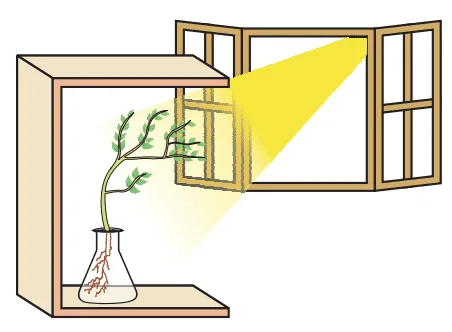
- Geotropic movement: The growth in a plant part in response to gravity is called geotropic movement. Roots usually show positive geotropic movement, i.e., they grow in the direction of gravity. Stems usually show negative geotropic movement.
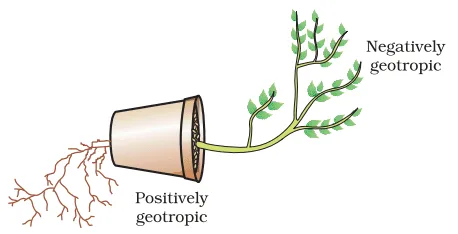
- Hydrotropic movement: When roots grow in the soil, they usually grow toward the nearest source of water. This shows a positive hydrotropic movement.
- Thigmotropic movement: The growth in a plant part in response to touch is called thigmotropic movement. Such movements are seen in the tendrils of climbers. The tendril grows in a way so that it can coil around support. The differential rate of cell division in different parts of the tendril happens due to the action of auxin.
Limitations to the use of electrical impulses:
- Firstly, they will reach only those cells that are connected by nervous tissue, not each and every cell in the animal body.
- Secondly, cells cannot continually create and transmit electrical impulses.
Chemical communication
If, instead of generating an electrical impulse, stimulated cells release a chemical compound, this compound would diffuse all around the original cell.
This will be slower, of course, but it can potentially reach all cells of the body, regardless of nervous
connections and it can be done steadily and persistently.
Different plant hormones help to coordinate growth, development, and responses to the environment. They are synthesized at places away from where they act and simply diffuse to the area of action.
Plant Hormones
- Auxin: When growing plants detect light, a hormone called auxin, synthesized at the shoot tip, helps the cells to grow longer. When light is coming from one side of the plant, auxin diffuses towards the shady side of the shoot. This concentration of auxin stimulates the cells to grow longer on the side of the shoot which is away from light. Thus, the plant appears to bend towards the light.
- Gibberellins: Gibberellins help in the growth of the stem.
- Cytokinins: Cytokinins promote cell division, and it is natural then that they are present in greater concentration in areas of rapid cell division, such as in fruits and seeds.
- Abscisic acid: It inhibits growth. Its effects include wilting of leaves.
Hormones in Animals
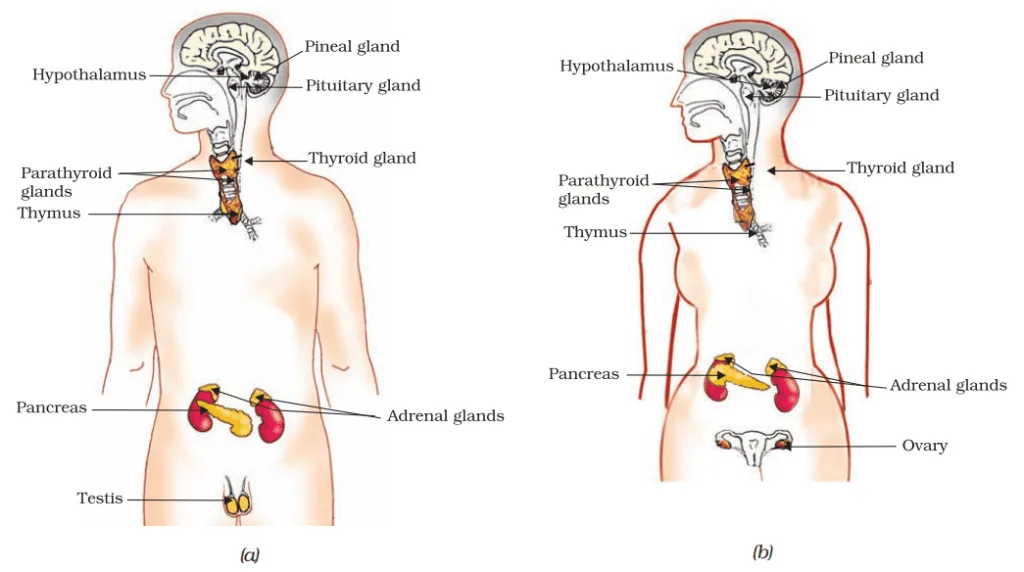
Adrenaline: The emergency hormone in our body is adrenaline. It helps in coping during emergencies as it is secreted directly into the blood and carried to different parts of the body as a result the heart beats faster, resulting in a supply of more oxygen to our muscles. The blood to the digestive system and skin is reduced due to the contraction of muscles around small arteries in these organs. This diverts the blood to our skeletal muscles. The breathing rate also increases because of the contraction of the diaphragm and rib muscles. All these responses together enable the animal body to be ready to deal with the emergency situation.
Thyroxine:
- Iodine is necessary for the thyroid gland to make thyroxin hormone. Thyroxin regulates carbohydrate, protein, and fat metabolism in the body so as to provide the best balance for growth.
- In case iodine is deficient in our diet, there is a possibility that we might suffer from goitre. One of the symptoms of this disease is a swollen neck.
Growth Hormone:
- The growth hormone is one of the hormones secreted by the pituitary. Growth hormone regulates the growth and development of the body.
- If there is a deficiency of this hormone in childhood, it leads to dwarfism.
Testosterone: It is secreted by the testes in males. Its functions include the development of male sex organs, hairs in public parts, cracking of voice, and changes associated with puberty.
Oestrogen: It is secreted by ovaries in females. Its functions include the development of female sex organs, regulates the menstrual cycle, and changes associated with puberty.
Insulin: This is a hormone that is produced by the pancreas and helps in regulating blood sugar levels. If it is not secreted in proper amounts, the sugar level in the blood rises causing many harmful effects (diabetes).
Releasing Hormones: It is released by the hypothalamus. Stimulates pituitary gland to release hormones.
Important Difference Betweens
1. Involuntary Actions Vs Reflex Actions
| Involuntary Actions | Reflex Actions |
| 1. Broader category. | 1. Specific response to stimuli. |
| 2. Do not need any kind of stimuli to work. | 2. Require stimulus for action. |
| 3. Regulated by brain. | 3. Regulated by spinal cord. |
| 4. May be quick or slow. | 4. Always quick. |
| 5. All involuntary actions are not reflex actions. | 5. All reflex actions are involuntary actions. |
| 6. Examples: Heartbeat, breathing, digestion, etc. | 6. Examples: blinking, kneejerk, hand withdrawal, etc. |
2. Nastic Movements vs Tropism
| Nastic Movements | Tropic Movements |
| 1. Growth independent | 1. Growth-dependent responses |
| 2. Happens due to cellular changes (changes in water pressure) | 2. Happens due to plant hormones |
| 3. Fast Response | 3. Slow response |
| 4. Non-directional | 4. Directional |
| 5. Example: Movement of leaves of the sensitive plant (Touch me not). | 5. Example: Movement of shoot towards light. |
3. Movement of leaves in sensitive plant Vs Movement in legs
| Movement in sensitive plant | Movement in legs |
| 1. Response to stimulus (involuntary action) | 1. Voluntary action. |
| 2. No special tissue for information transfer | 2. CNS & PNS for information exchange. |
| 3. Movement due to water loss in leaves. | 3. Special proteins help muscles contract. |
4. Nervous System Vs Hormonal System
| Nervous System | Hormonal System |
| 1. Fast speed | 1. Slow speed |
| 2. Electrical impulses travel through nerve fibre | 2. Chemical messengers (hormones) travel through blood. |
| 3. Short-lived effect | 3. Long-lasting effect |
| 4. Cannot reach all cells in the body. | 4. Can reach all cells in the body. |
🧠 Class 10 Science Chapter 7: Control and Coordination
📘 NCERT Solutions | CBSE 2025–26 | Biology
🔹 Intext Questions (Page 119)
Q1. What is the difference between a reflex action and walking?
✅ Answer:
| Reflex Action | Walking |
|---|---|
| Involuntary and automatic | Voluntary action |
| Fast response to stimulus | Controlled by brain consciously |
| Done by spinal cord | Coordinated by brain and muscles |
Q2. What happens at the synapse between two neurons?
✅ Answer:
At the synapse, electrical signals trigger the release of chemical messengers (neurotransmitters), which cross the synaptic gap and stimulate the next neuron, continuing the signal transmission.
Q3. Which part of the brain maintains posture and equilibrium of the body?
✅ Answer:
Cerebellum
Q4. How do we detect the smell of an agarbatti (incense stick)?
✅ Answer:
Olfactory receptors in the nose detect smell and send signals via sensory neurons to the brain, which processes and identifies it.
Q5. What is the role of the brain in reflex action?
✅ Answer:
The brain is not involved in initiating reflex actions. Reflexes are processed by the spinal cord, but the brain becomes aware of the reflex after it occurs.
🔹 Intext Questions (Page 122)
Q1. What are plant hormones?
✅ Answer:
Plant hormones (phytohormones) are chemical substances that control growth and responses in plants. Examples: auxins, gibberellins, cytokinins, abscisic acid.
Q2. How is the movement of leaves of the sensitive plant different from the movement of a shoot towards light?
✅ Answer:
| Movement in Sensitive Plant | Movement of Shoot towards Light |
|---|---|
| Nastic (non-directional) | Tropic (directional) |
| Due to turgor pressure changes | Due to differential growth |
| Rapid and temporary | Slow and permanent |
Q3. Give an example of a plant hormone that promotes growth.
✅ Answer:
Auxin – promotes cell elongation and growth.
Q4. How do auxins promote the growth of a tendril around a support?
✅ Answer:
Auxins accumulate on the side away from the support, promoting faster cell growth on that side, causing the tendril to bend toward the support.
Q5. Design an experiment to demonstrate hydrotropism.
✅ Answer:
Place a plant horizontally in a box with one side having moist soil and the other dry. After a few days, roots will grow toward the moist soil, showing hydrotropism.
🔹 Intext Questions (Page 125)
Q1. How does chemical coordination occur in animals?
✅ Answer:
Through hormones secreted by endocrine glands, which travel via blood to target organs and regulate body functions.
Q2. Why is the use of iodised salt advisable?
✅ Answer:
Iodine is necessary for the thyroid gland to produce thyroxine. Iodised salt prevents goitre and maintains metabolism.
Q3. How does adrenaline help the body to deal with emergency situations?
✅ Answer:
Adrenaline increases heartbeat, breathing rate, and blood flow to muscles, preparing the body for "fight or flight" response.
Q4. Why are some patients of diabetes treated by giving injections of insulin?
✅ Answer:
Because their pancreas does not produce enough insulin, which is needed to regulate blood sugar. Injecting insulin helps control glucose levels.
🔹 NCERT Back Exercise Questions (Page 126–127)
Q1. Which of the following is a plant hormone?
(a) Insulin (b) Thyroxine (c) Estrogen (d) Cytokinin
✅ Answer: (d) Cytokinin
Q2. The gap between two neurons is called a:
(a) Dendrite (b) Synapse (c) Axon (d) Impulse
✅ Answer: (b) Synapse
Q3. The brain is responsible for:
(a) Thinking (b) Regulating heart beat (c) Balancing the body (d) All of the above
✅ Answer: (d) All of the above
Q4. What is the function of receptors in our body?
✅ Answer:
Receptors detect changes in the environment (stimuli) and send signals to the brain or spinal cord for a response.
Q5. Draw the structure of a neuron and explain its function.
✅ Answer:
(Diagram must include dendrite, cell body, axon, nerve ending)
Function: Neurons transmit information in the form of electrical impulses throughout the body.
Q6. How does phototropism occur in plants?
✅ Answer:
Auxins accumulate on the darker side of the shoot, causing that side to grow faster and the shoot to bend toward light.
Q7. Which signals will get disrupted in case of a spinal cord injury?
✅ Answer:
Reflex actions and involuntary movements will be disrupted as the spinal cord processes reflexes.
Q8. How does chemical coordination occur in plants?
✅ Answer:
Via plant hormones like auxins, gibberellins, cytokinins, abscisic acid, and ethylene that regulate growth and responses.
Q9. What is the need for a system of control and coordination in an organism?
✅ Answer:
To process and respond to stimuli, maintain internal balance, and coordinate various body functions for survival.
Q10. How are involuntary actions and reflex actions different?
✅ Answer:
| Reflex Action | Involuntary Action |
|---|---|
| Fast, protective | May or may not be protective |
| In response to stimulus | May occur without stimulus |
| Controlled by spinal cord | Controlled by brain (e.g. heartbeat) |
Q11. Compare and contrast nervous and hormonal mechanisms of control.
✅ Answer:
| Nervous System | Hormonal System |
|---|---|
| Fast, electrical signals | Slow, chemical messengers |
| Acts on specific organs | Can affect multiple organs |
| Short-lived response | Long-lasting response |
🧠 Control and Coordination – CBSE Previous Year Questions (PYQs)
📚 Class 10 Science | Biology | Chapter 7
🔹 1-MARK QUESTIONS
-
Name the part of the brain which controls posture and balance.
📅 CBSE 2017
✅ Answer: Cerebellum -
What is the function of receptors in our body?
📅 CBSE 2019
✅ Answer: They detect stimuli and send signals to the brain/spinal cord. -
How is the movement in sensitive plant (Mimosa) different from movement in a sunflower?
📅 CBSE 2020
✅ Answer: Sensitive plant movement is non-directional (nastic), sunflower shows directional (tropic) movement. -
Give an example of a plant hormone that promotes growth.
📅 CBSE 2018
✅ Answer: Auxin or Gibberellin
🔹 2-MARK QUESTIONS
-
Distinguish between voluntary and involuntary actions. Give one example of each.
📅 CBSE 2020
| Voluntary Action | Involuntary Action |
|---|---|
| Under conscious control | Not under conscious control |
| Example: Walking | Example: Heartbeat |
-
Why is the spinal cord called the center of reflex action?
📅 CBSE 2019
✅ Answer: Because it processes reflex actions without involving the brain, providing quick responses.
-
What are phytohormones? Name two plant hormones and state their functions.
📅 CBSE 2021 (Compartment)
✅ Answer:
-
Phytohormones are chemical substances in plants that regulate growth and response.
-
Examples:
-
Auxin: Promotes cell elongation
-
Abscisic acid: Inhibits growth and promotes dormancy
-
-
Why is the use of iodised salt advisable?
📅 CBSE 2016
✅ Answer: Iodine is required for the synthesis of thyroxine by the thyroid gland. Deficiency leads to goitre.
🔹 3-MARK QUESTIONS
-
How does the human brain control and coordinate the body? List its three major parts and write one function of each.
📅 CBSE 2019
✅ Answer:
-
Cerebrum – Voluntary actions, thinking
-
Cerebellum – Posture and balance
-
Medulla – Involuntary functions like breathing
-
What are plant hormones? Write the names of four different plant hormones. State their functions.
📅 CBSE 2022
✅ Answer:
-
Auxin: Growth of stem
-
Gibberellin: Elongation of stem
-
Cytokinin: Cell division
-
Abscisic acid: Inhibits growth
-
What is a reflex arc? Explain with the help of a labelled diagram.
📅 CBSE 2018
✅ Answer: Diagram should include: receptor, sensory neuron, spinal cord, motor neuron, effector
-
Differentiate between tropic and nastic movements in plants. Give examples.
📅 CBSE 2017
✅ Answer:
-
Tropic – Directional movement toward stimulus (e.g. phototropism)
-
Nastic – Non-directional response (e.g. touch in Mimosa)
-
What are hormones? Name the hormone secreted by the pancreas and give its function.
📅 CBSE 2021
✅ Answer:
-
Hormones are chemical messengers
-
Insulin: Regulates blood glucose levels
🔹 5-MARK QUESTIONS
-
Draw a neat labelled diagram of a neuron. Explain how information travels in it.
📅 CBSE 2020
✅ Answer:
-
Include dendrites, axon, axon terminal
-
Electrical signal travels along axon; chemical transmission at synapse
-
Describe the structure and function of the human brain.
📅 CBSE 2022
✅ Answer:
-
Parts: Cerebrum, cerebellum, medulla, hypothalamus
-
Protected by skull and cerebrospinal fluid
-
Coordinates voluntary and involuntary actions
-
Describe how adrenaline prepares the body for fight or flight during emergency situations.
📅 CBSE 2019
✅ Answer:
-
Increases heart rate, breathing rate, blood to muscles
-
Dilates pupils, increases alertness
-
What is phototropism? Draw a labelled diagram showing phototropic movement in a plant.
📅 CBSE 2016
✅ Answer:
-
Growth movement in response to light
-
Shoot bends toward light; auxins move to darker side
📌 Frequently Asked Topics in CBSE Board
| Concept | Common Marks | Frequency |
|---|---|---|
| Human Brain & Functions | 3M, 5M | Very High |
| Reflex Arc & Reflex Action | 3M | High |
| Plant Hormones & Tropisms | 2M, 3M | High |
| Hormonal Coordination (Adrenaline, Insulin, Thyroxine) | 2M, 3M | High |
| Neuron Diagram | 3M, 5M | Moderate |



Comments
Post a Comment